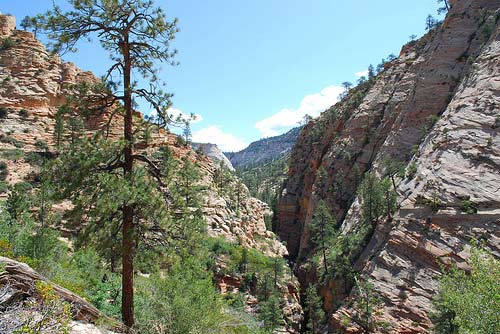
At the turn of the 20th century, the region now encompassed by Zion National Park saw few visitors. This all changed in 1908, however, when a federal land survey exposed the area to the general public. Struck by its natural splendor, the surveyors encouraged President Taft to protect the region, and he obliged. In 1909, Taft established Mukuntuweap National Monument. Nine years later, it became Zion National Monument. And on November 19, 1919 — 93 years ago today — the area was expanded and designated Zion National Park.
Located in southwestern Utah, Zion encompasses 229 square miles, including some of the most scenic canyon country in all of the United States. With elevations ranging from 3,600 to 8,700 feet, it is home to diverse plant communities, supporting more than 900 different species. These elevation changes, in combination with temperature ranges and varying amounts of sun and water, are responsible for the park’s mosaic of plant habitats. Let’s take a look at five of its ecosystems:
- Riparian: The relative lushness of Zion Canyon comes as a surprise to most visitors. The riparian area of the Virgin River, which snakes through the canyon, supports giant cottonwood trees and a variety of other plants and grasses. Cattails, willows and aquatic plants inhabit the saturated wetlands nearby, and water seeps out of the towering Navajo sandstone, creating beautiful springs and the distinctive hanging gardens for which Zion is known. Ferns, wildflowers and mosses decorate these canyon walls.
- Arid Grasslands and Desert Shrubs: Drought tolerant plants, particularly desert shrubs, thrive in the lower elevations of the park. Grasses bloom and go to seed during the summer months, and cacti are a frequent sight.
- Pinyon-juniper Forest: Climbing upwards in elevation, the arid grasslands and desert shrubs are replaced by pinyon-juniper forest. These evergreen trees grow slowly and are both cold and drought tolerant, supporting a great diversity of wildlife.
- Ponderosa Pine: Higher still, on the sandstone cliffs, ponderosa pines cling to cracks and ledges. The powerful roots of these enormous trees wedge themselves into the Navajo sandstone, contributing to the gradual process of erosion that is forever changing the face of Zion.
- Mixed Conifer and Aspen Forest: On the high plateaus, ponderosa pines meet Douglas-fir, white pine and aspen trees.

With such a variety of microclimates, it comes as no surprise that Zion National Park is host to a great diversity of animal life — 78 mammal species, 291 bird species, 44 reptile and amphibian species and eight fish species, to be exact. It also provides critical habitat for the threated Mexican spotted owl, a small population of Mojave Desert tortoises and the endangered southwestern willow flycatcher.
From the magnificent hanging gardens deep in its canyons to the resilient forest blanketing its high plateaus, the breadth of Zion National Park’s flora and fauna is truly staggering. Happy birthday to this one-of-a-kind beauty!